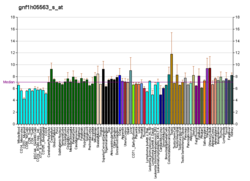| OR4D5 |
|---|
|
| Identifiers |
|---|
| Aliases | OR4D5, OR11-276, olfactory receptor family 4 subfamily D member 5 |
|---|
| External IDs | MGI: 3030818; HomoloGene: 17314; GeneCards: OR4D5; OMA:OR4D5 - orthologs |
|---|
| Gene location (Human) |
|---|
 | | Chr. | Chromosome 11 (human)[1] |
|---|
| | Band | 11q24.1 | Start | 123,939,617 bp[1] |
|---|
| End | 123,940,573 bp[1] |
|---|
|
| Gene location (Mouse) |
|---|
 | | Chr. | Chromosome 9 (mouse)[2] |
|---|
| | Band | 9|9 A5.1 | Start | 40,007,811 bp[2] |
|---|
| End | 40,025,502 bp[2] |
|---|
|
| RNA expression pattern |
|---|
| Bgee | | Human | Mouse (ortholog) |
|---|
| | | More reference expression data |
|
|---|
| BioGPS |  | | More reference expression data |
|
|---|
|
| Gene ontology |
|---|
| Molecular function | - G protein-coupled receptor activity
- olfactory receptor activity
- transmembrane signaling receptor activity
- signal transducer activity
| | Cellular component | - integral component of membrane
- plasma membrane
- membrane
| | Biological process | - sensory perception of smell
- detection of chemical stimulus involved in sensory perception of smell
- detection of chemical stimulus involved in sensory perception
- signal transduction
- response to stimulus
- G protein-coupled receptor signaling pathway
| | Sources:Amigo / QuickGO |
|
| Orthologs |
|---|
| Species | Human | Mouse |
|---|
| Entrez | | |
|---|
| Ensembl | | |
|---|
| UniProt | | |
|---|
| RefSeq (mRNA) | | |
|---|
| RefSeq (protein) | | |
|---|
| Location (UCSC) | Chr 11: 123.94 – 123.94 Mb | Chr 9: 40.01 – 40.03 Mb |
|---|
| PubMed search | [3] | [4] |
|---|
|
| Wikidata |
| View/Edit Human | View/Edit Mouse |
|



















